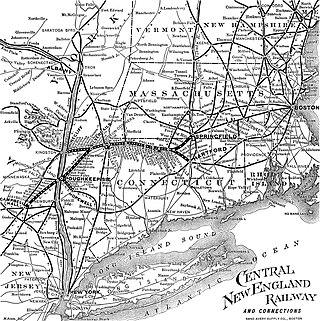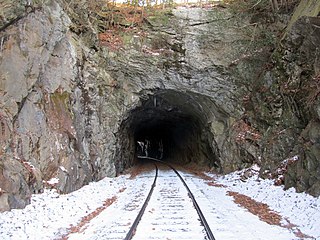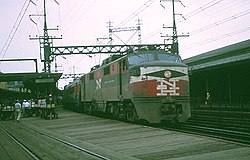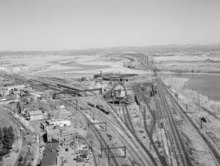
Metro-North Railroad, trading as MTA Metro-North Railroad, is a suburban commuter rail service operated by the Metropolitan Transportation Authority (MTA), a public authority of the U.S. state of New York. Metro-North serves the New York Metropolitan Area, running service between New York City and its northern suburbs in New York and Connecticut, including Port Jervis, Spring Valley, Poughkeepsie, Yonkers, New Rochelle, Mount Vernon, White Plains, Southeast and Wassaic in New York and Stamford, New Canaan, Danbury, Bridgeport, Waterbury, and New Haven in Connecticut. Service in Connecticut is operated under contract with the Connecticut Department of Transportation. Metro-North also provides local rail service within the New York City boroughs of Manhattan and the Bronx.

The Northeast Corridor (NEC) is an electrified railroad line in the Northeast megalopolis of the United States. Owned primarily by Amtrak, it runs from Boston in the north to Washington, D.C. in the south, with major stops in Providence, New Haven, Stamford, New York City, Newark, Trenton, Philadelphia, Wilmington, and Baltimore. The NEC closely parallels Interstate 95 for most of its length. Carrying more than 2,200 trains a day, it is the busiest passenger rail line in the United States by ridership and by service frequency.

The MBTA Commuter Rail system serves as the commuter rail arm of the Massachusetts Bay Transportation Authority's (MBTA's) transportation coverage of Greater Boston in the United States. Trains run over 394 mi (634 km) of track to 134 stations. It is operated under contract by Keolis, which took over operations on July 1, 2014, from the Massachusetts Bay Commuter Railroad Company (MBCR).

The Providence and Worcester Railroad is a Class II railroad operating 612 miles (985 km) of tracks in Rhode Island, Massachusetts, and Connecticut, as well as New York via trackage rights. The company was founded in 1844 to build a railroad between Providence, Rhode Island, and Worcester, Massachusetts, and ran its first trains in 1847. A successful railroad, the P&W subsequently expanded with a branch to East Providence, Rhode Island, and for a time leased two small Massachusetts railroads. Originally a single track, its busy mainline was double-tracked after a fatal 1853 collision in Valley Falls, Rhode Island.

The Central New England Railway was a railroad from Hartford, Connecticut, and Springfield, Massachusetts, west across northern Connecticut and across the Hudson River on the Poughkeepsie Bridge to Maybrook, New York. It was part of the Poughkeepsie Bridge Route, an alliance between railroads for a passenger route from Washington to Boston, and was acquired by the New York, New Haven & Hartford Railroad in 1904. The New Haven ran the CNE as a separate company until finally merging it in 1927. The vast majority of the system was abandoned by the 1930s and 1940s. Surviving portions of the Central New England Railway are operated by the Central New England Railroad and the Housatonic Railroad.

The Old Colony Railroad (OC) was a major railroad system, mainly covering southeastern Massachusetts and parts of Rhode Island, which operated from 1845 to 1893. Old Colony trains ran from Boston to points such as Plymouth, Fall River, New Bedford, Newport, Providence, Fitchburg, Lowell and Cape Cod. For many years the Old Colony Railroad Company also operated steamboat and ferry lines, including those of the Fall River Line with express train service from Boston to its wharf in Fall River where passengers boarded luxury liners to New York City. The company also briefly operated a railroad line on Martha's Vineyard, as well as the freight-only Union Freight Railroad in Boston. The OC was named after the "Old Colony", the nickname for the Plymouth Colony.

The New York and New England Railroad (NY&NE) was a railroad connecting southern New York State with Hartford, Connecticut; Providence, Rhode Island; and Boston, Massachusetts. It operated under that name from 1873 to 1893. Prior to 1873 it was known as the Boston, Hartford and Erie Railroad, which had been formed from several smaller railroads that dated back to 1846. After a bankruptcy in 1893, the NY&NE was reorganized and briefly operated as the New England Railroad before being leased to the competing New York, New Haven and Hartford Railroad in 1898.

The Cape Cod Railroad is a railroad in southeastern Massachusetts, running from Pilgrim Junction in Middleborough across the Cape Cod Canal Railroad Bridge, where it splits towards Hyannis in one direction and Falmouth in the other. It was incorporated in 1846 as the Cape Cod Branch Railroad to provide a rail link from the Fall River Railroad line in Middleborough to Cape Cod.

The Norfolk County Railroad was a railroad in Massachusetts, United States. Chartered as two different companies in 1846 and 1847, it completed a rail line between Dedham and Blackstone in 1849. A branch to Medway, Massachusetts was built in 1852. The railroad was leased by the Boston and New York Central Railroad, succeeded by the Boston and Providence Railroad and the East Thompson Railroad, before the Norfolk County Railroad returned to independent operation in 1858. In 1866, the Boston, Hartford and Erie Railroad leased the Norfolk County. The Rhode Island and Massachusetts Railroad was completed in 1877 from Franklin southward to Valley Falls, Rhode Island, and became a branch of the Norfolk County mainline. The northernmost portion of the main line from Islington to Dedham was rerouted to the east in 1881, and the original alignment abandoned two years later. The New York, New Haven and Hartford Railroad assumed operation of the Norfolk County lines in 1898.

The Housatonic Railroad is a Class III railroad operating in southwestern New England and eastern New York. It was chartered in 1983 to operate a short section of ex-New York, New Haven and Hartford Railroad in northwestern Connecticut, and has since expanded north and south, as well as west into New York State.

The Naugatuck Railroad is a common carrier railroad owned by the Railroad Museum of New England and operated on tracks leased from the Connecticut Department of Transportation. The original Naugatuck Railroad was a railroad chartered to operate through south central Connecticut in 1845, with the first section opening for service in 1849. In 1887 the line was leased by the New York, New Haven and Hartford Railroad, and became wholly owned by 1906. At its greatest extent the Naugatuck ran from Bridgeport north to Winsted. Today's Naugatuck Railroad, formed in 1996, runs from Waterbury to the end of track in Torrington, Connecticut. From Waterbury south to the New Haven Line, Metro-North Railroad operates commuter service on the Waterbury Branch.

The New Haven–Springfield Line is a railroad line owned by Amtrak from New Haven, Connecticut, north to Springfield, Massachusetts, serving the Knowledge Corridor. As a branch of the Northeast Corridor just north of New Haven State Street station, it is served by approximately seven daily Northeast Regional round trips, some continuing from New Haven to Washington, D.C., along the Corridor and others terminating at New Haven as shuttles. On weekends, there is one train daily to Roanoke, Virginia. It is also served by the daily Vermonter, which starts in Washington, D.C., and continues north from Springfield, finally terminating in St. Albans, Vermont. The line is part of the Inland Route connecting Boston and New York via Hartford, Springfield, and Worcester, in contrast to the "Shore Line" along the Connecticut Shore and through Rhode Island.

The Middleboro Secondary is a railroad line owned by MassDOT in the U.S. state of Massachusetts. The line runs from Attleboro to Middleborough via Taunton.

Readville station is a Massachusetts Bay Transportation Authority (MBTA) commuter rail station located in the Readville section of the Hyde Park neighborhood of Boston, Massachusetts. It is served by MBTA Commuter Rail Fairmount Line and Franklin/Foxboro Line. Readville is the outer terminus for most Fairmount service, though some trips continue as Franklin/Foxboro Line trains. The station is located at a multi-level junction, with the Northeast Corridor tracks at ground level and the Dorchester Branch above; Franklin/Foxboro Line trains use a connecting track with a separate platform. Platforms are available for the Providence/Stoughton Line on the Northeast Corridor tracks, but they are not regularly used. An MBTA maintenance and storage yard and a CSX Transportation freight yard are located near the station.

The Hartford and New Haven Railroad (H&NH), chartered in 1833, was the first railroad built in the state of Connecticut and an important direct predecessor of the New York, New Haven and Hartford Railroad. The company was formed to connect the cities of New Haven, Connecticut, and Springfield, Massachusetts. It built northwards from New Haven, opening its first segment in 1838, and reaching Hartford in December 1839. The company reached Springfield in 1844 under the auspices of the Hartford and Springfield Railroad, a subsidiary chartered in Massachusetts. Branches were later built to Suffield, New Britain, and Middletown and operated by the Hartford and New Haven. The H&NH merged with the New York and New Haven Railroad in 1872, forming the New York, New Haven and Hartford Railroad.

The Norwich and Worcester Railroad (N&W) was a railroad in the U.S. states of Connecticut and Massachusetts. Its north-south mainline ran between its namesake cities of Worcester, Massachusetts, and Norwich, Connecticut,. The Providence and Worcester Railroad (P&W) owns the ex-N&W line and operates freight service.

Newington Junction is a bus rapid transit station on the CTfastrak line opened in 2015 located off Willard Avenue (CT-173) in the Newington Junction neighborhood of Newington, Connecticut.

The Connecticut Valley Railroad was a railroad in the state of Connecticut founded in 1868. The company built a line along the Connecticut River between Hartford and Old Saybrook, which opened in 1871. It was reorganized as the Hartford and Connecticut Valley Railroad in 1880, and leased by the New York, New Haven and Hartford Railroad in 1887. Following partial abandonments by the New Haven Railroad and successor Penn Central Transportation Company between 1968 and 1972, the line south of Middletown was revived as the Valley Railroad, a heritage railroad, while the portion in Middletown and northward saw operation by several freight railroads. As of 2022, the Providence and Worcester Railroad and Connecticut Southern Railroad both operate portions of the former Connecticut Valley Railroad.

The Dedham Branch was a spur line of the Boston and Providence Railroad, opened in 1835, which ran from the junction with the main line at Readville through to central Dedham; it was the first railroad branch line in Massachusetts. In 1966, it became part of the MBTA Commuter Rail system, but was abandoned the next year.

Railroads have played an important role in New England ever since the Granite Railway, America's first commercial railway, began operations in Massachusetts in 1826. As industrialization spread across the region, hundreds of railroads were built throughout the 19th century. Railroad mileage peaked around World War I, and from that point on mileage began to shrink. Despite this, railroads continue to be important for freight and passenger transportation in the region, with the New Haven Line holding the title of busiest railroad line in the entire United States.































